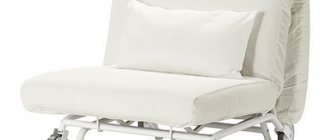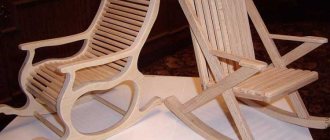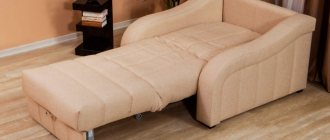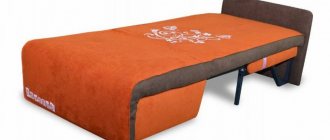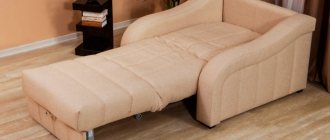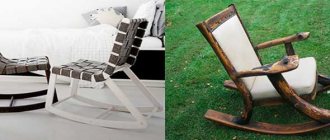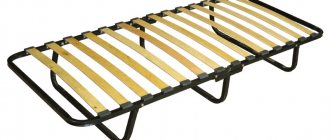Cosmetic repair of chairs at home
Chair repair is one of the simplest types of home furniture repairs. Even a person who does not have the skills to make upholstered or cabinet furniture can learn this business. At home, you have to repair old “Soviet-style” chairs with wooden or soft armrests, as well as office chairs.
For work you will need cotton and upholstery fabrics, foam rubber or other filler. If you need to replace or update fasteners and wooden elements, you will have to buy wood glue, stain, varnish of a suitable shade, putty, boards, screws, nails, sandpaper (if you don’t have a sanding machine).
You can't do without a minimum set of tools. The craftsman will need a pencil, tape measure, screwdriver, scissors, hammer, brushes, furniture stapler, and grinder.
What is not allowed to be done during disassembly?
It is unacceptable to make rough and powerful movements - such an approach to business is fraught with breaking parts of the furniture, tearing its coverings or breaking fasteners.
If disassembly is done for the purpose of repairing the frame or replacing the upholstery, it is not permissible to leave part of the fittings unremoved. By the way, it doesn’t hurt to take a photo of the places where it is attached, so that later, when assembling, you don’t get confused.
In the case of dismantling a chair to move it to another room, it is strictly not recommended to do this in part, leaving parts of the furniture articulated, only loosening the fastenings and bending the parts to create a narrower system. This is often done. This often ends in failure.
Preparation for restoration of a classic chair with wooden armrests
If you need to repair an old chair, then work should begin by removing the upholstery using a utility knife. The resulting fabric fragments will be used in the future as patterns for new upholstery. When choosing materials for restoring a product, you need to pay attention to the quality and density of the fabric: material that is not strong enough will fall apart during use.
At the first stage of work, it is necessary to disassemble the chair into its component parts: seat, back, armrests, legs. First, free the furniture from upholstery and old filling, and then unscrew the bolts with a screwdriver. Wooden elements must be carefully inspected; if there are cracks, chips or other defects on the wood, they are eliminated with wood glue or putty.
If the damage cannot be removed using these methods, the relevant parts are replaced. New elements that match the shape and size of the old parts can be cut from the boards. After this, the wooden parts are impregnated with an antifungal agent and dried thoroughly.
The finished elements are sanded with sandpaper or a grinding machine. The grain size is determined by the texture of the wood being processed - the coarser the fibers, the larger the sandpaper grain should be. The work is considered complete when the surface of the material becomes smooth.
After this, the parts need to be wiped with a dry cloth (to remove dust) and covered with stain, which will take about 7 hours to absorb. At the next stage, the parts are coated with a thin layer of varnish and dried for three days.
Instructions for replacing upholstery and filling of seats and backrests
Do-it-yourself chair repair is not complete without replacing the upholstery and filling, since these structural elements are prone to wear during use.
Updating the seat begins with tightening the furniture straps on the underside of the seat. They should be positioned crosswise. The belts are secured with special nails, after which the bottom of the chair is covered with durable fabric that will protect the belts from wear. The fabric is attached to the base with nails or furniture staples.
Cotton fabric must be stretched over the prepared frames and secured with staples. Then you should cut out the foam blank along the contour of the seat with a margin, apply glue to the edges of the fabric and carefully glue the filler. The edges of the foam rubber are secured with a furniture stapler on the back side of the seat. In no case should glue be applied in the middle of the product, because the front side of the filler on the seat and back should bend so that the person can sit comfortably.
The foam rubber is covered with upholstery fabric on top, which is stretched, leveled and fixed on the back side of the seat. When cutting upholstery fabric, it is recommended to make allowances of 5-7 cm on each side. This is necessary so that the fabric does not come apart while using the furniture.
The right tool
Let's move from words to action. In order to create a restoration of an old chair, we will need the following tool:
- Hammer, pliers, screwdriver (flat),
- Manual stapler, staples from 4 to 6 mm, scissors,
- Wide sling (textile),
- Foam rubber, batting, synthetic winterizer,
- Tissue (medical system of cells and intercellular substance, united by a common origin, structure and functions)
(1.5 – 2 m), - PVA glue, gauze.
Final assembly of the product
When the upholstery is done, you need to find the places where the holes for the screws are located in the wooden frame. These points are marked on the fabric with chalk and specified. After this, small holes are made in appropriate places using scissors. The edges of the resulting holes are treated with colorless nail polish or fire. The fabric around the holes is additionally secured with staples.
Now the master’s task is to connect all the parts of the chair with each other. The structural elements are fastened using self-tapping screws, which are installed in the same places in which they were previously located. To increase the strength of the fasteners, you can fix the fasteners with wood glue.
As work progresses, it is necessary to check the evenness and strength of all joints, and, if necessary, knock out the joints of the parts with a hammer. When everything is ready, all that remains is to check whether individual parts of the product are wobbly. After this, the chair can be used for its intended purpose.
Corner sofa: nuances of analysis
Disassembling a corner sofa for moving is a more difficult task. It seems that there are a huge number of configuration options for such furniture - it can have a folding block in the form of a book, a “dolphin”, an accordion, and the side block can be an ottoman with a lifting mechanism.
In fact, it is important to highlight only two design options for a soft corner:
- models in which the blocks are connected by a corner element;
- model with a sofa located perpendicular to the main block.
If the backrest consists of pillows - great, they should be removed immediately. After that, free up the space around the sofa. First of all, remove the sides and back strip from the soft corner. Afterwards, disconnect the corner part from the main one.
The mechanism is disassembled in a familiar way - one of those described above.
Office chair repair
An integral element of the workplace is a comfortable computer chair. But it, like any other piece of furniture, tends to wear out. And if complex mechanisms are quite difficult to repair (in most cases they have to be replaced), then you can update the exterior of the chair yourself, at home.
First of all, you need to disassemble the chair, or rather remove from it those parts that need repair. It is necessary to disconnect the handles and backrest by unscrewing the fastening screws using a karst screwdriver. After this, the upper part of the seat, covered with fabric, can be easily removed.
The main difficulties for novice craftsmen arise at the next stage, when you need to remove the protective cover of the back, but not a single fastening element is visible. To understand how the casing is attached to the backrest, you should pull one of its corners with force. The cover is secured using four special latches, which open when they try to pull the cover off the structure.
The fabric should be detached manually, without using additional tools, as excessive mechanical stress can lead to breakage of the latches. You should also carefully install the casing in place, tapping with your fist (but not with a hammer!) at the location of the latch.
The most difficult part of the job is fitting the parts correctly. The fabric blank must be placed on the frame and stretched so that there are no folds on the front side. The tension should be distributed evenly; for this it is recommended to staple each side in the center (with a cross). Then you need to fix the corners, and only after that should you lay out the sides parallel to each other.
Do not be afraid to use a standard furniture stapler, as it can easily hammer staples into the plastic from which office chairs are made. If errors occur, the brackets can be removed by prying them off with a flat-head screwdriver. When the seat and back are covered, you need to trim off the excess fabric and assemble the structure.
If desired, you can cover the crosspiece and armrests of the chair with fabric or leather. The product is ready to use!
Source: nedvijdom.ru
Loading and transportation of furniture
The priority task is to properly organize the process of removing items. Pre-measure the doorways of the apartment, entrance, office. Analyze whether the object can navigate the turns in the stairwell without damage. Check the elevator's lifting capacity and the opening width of the doors. If it is not possible to carry the load, remove all elements. Don't skimp on professional movers. A specialist will be able to foresee all the nuances and move heavy objects without risks.
Important loading steps:
- a layout of elements in the body is preliminarily developed;
- with the help of rigging tools, objects are moved into the machine - platforms, elevators, manipulators, rails;
- placement - different types of furniture are placed separately so that they do not touch on the road;
- loaders provide reliable fixation. Not all vehicles are equipped with mounting systems. This is provided in the transport of an experienced logistician. Ignoring the requirement will lead to numerous damages along the way, falling objects, and severe shaking.
For safe transportation, choose a specialized vehicle.
- Belts and harnesses for tight fixation.
- Soft rollers.
- Covered awnings protecting from precipitation and wind.
- Soft walls.
- Wooden fenders around the perimeter of the side.
You need to know how to use the devices in order to securely fix objects.
Features of reupholstering an office chair with your own hands: instructions and recommendations
Modern people spend a lot of time at the computer, both in the office and at home. Obviously, it is better to work not sitting on a hard stool or listening to the creaking of an old chair, but sitting comfortably in one of the office chairs offered by manufacturers. Unfortunately, from active use, the upholstery of the chair quickly becomes unusable - the artificial leather cracks or becomes frayed, the fabric gets dirty and torn. What should you do - throw away your expensive office chair or try to restore it?
What to use?
To upholster an old chair, you should not buy artificial leather or thin fabrics - the former will quickly lose its attractive appearance, and the fragile material can even wear out quickly. Also, during such a process as reupholstering a computer chair, you may need foam rubber, since the old lining, as a rule, swells over time and loses its qualities.
If only the seat of the furniture is damaged, then the upholstery of the back of the office chair does not need to be retightened and vice versa. But to create a sample with an attractive appearance, it is better to make sure that both parts of the chair match each other in color and texture of the chosen fabric, that is, we will have to restore the chair as a whole.
To carry out the constriction you will need:
- screwdriver or screwdriver;
- scissors.
Overview of species
Nowadays, furniture factories produce a great variety of different models of chairs, complemented by wooden sides. This furniture differs both in its direct design and in the materials used. The final cost of the finished product depends on these factors. Let us consider in detail what types of chairs there are that differ from each other according to the indicated characteristics.
By design
Compact upholstered furniture with wooden side parts can have different designs
Each specimen has its own device features, which are important to consider when selecting similar products.
Standard models. The most widespread options found in many homes. They can be recognized by one distinctive feature - the arrangement of their legs. The supports in such a furniture design can be either straight or elegantly curved and will definitely be present. The role of decorative and functional details that positively influence the level of comfort of furniture can be side supporting structures - the so-called “wings”, roller-type armrests or poufs.
Based on materials
Chairs with wooden sides differ not only in design, but also in the materials used to make the frame base.
- Wood (natural). Environmentally friendly and durable option. It emits pleasant aromas, but such a frame will require periodic treatment with antiseptics. Can be expensive.
- Chipboard or MDF. Inexpensive materials. Inferior to natural wood in many respects. Laminated chipboard is completely toxic, since it contains formaldehyde. Only materials of classes E-1 or E-0 are safe.
- Metal. Furniture with a metal frame is the most reliable, durable, non-capricious and wear-resistant. But such products have an impressive mass - they can be difficult to transport or rearrange from place to place. Their weight may leave unsightly marks on the floor.
Rarely is a frame made from one type of material. Combinations of several types are usually used. Most often, metal is used at the base of the racks, fasteners and lower stops, but the entire structure, as a rule, is metal only in the case of garden furniture.
The upholstery of chairs with wooden armrests also varies. The following materials are suitable:
- leather (natural or artificial);
- jacquard;
- shennyl;
- tapestry;
- silk;
- velveteen;
- organza and many others.
Principles of repair
How to reupholster a chair and what are the stages of this process?
First you need to disassemble the chair and get rid of the old upholstery. When carrying out repairs, we perform a number of simple steps:
- Remove the back of the chair by turning the screw at the back and disconnect the armrests. Remove the back panel.
When choosing fabric, it is important to purchase as much of it as you need for upholstery - to do this, measure the chair and add to the resulting figures another 5-7 centimeters necessary for upholstery.
How to clean at home?
Sometimes you can update an office chair without such an operation as replacing the upholstery, simply by removing the greasy gloss that has appeared over time, as well as greasy stains. How to clean the upholstery of a computer chair, even if it stinks, for example, because beer or soup was spilled on it? This is not difficult to do. Apply the soap solution to the surface with a sponge and then remove it using circular movements. Some dirt can be removed using a regular vacuum cleaner - by moistening the brush in a saline solution and wrapping it, for example, in gauze, you just need to vacuum the chair.
Household dust stains can be easily cleaned with a vinegar solution (2 tablespoons per liter of water).
Chair cover
To make the chair last longer and not require reupholstery, you can provide it with a cover that will protect the piece of furniture and allow it to fit more seamlessly into the interior. Most often, this requires sewing two separate elements - a cover for the back and a cover for the seat. But if the chair is a single structure, the approach will be slightly different:
- Let's take tracing paper and apply it to each of the elements of the chair, tracing them with a marker. By cutting out these outlines, we will obtain patterns from which we will create these elements from fabric.
- When planning to cut out the future cover, do not forget to leave allowances for the seams. Also, when creating elements of a seat cover, you can leave a few centimeters of fabric to create a “tunnel” in which the elastic can be placed. Such a cover will fit tightly to the skin without causing any trouble.
The “clothing” for the chair is easy to remove and wash. If scuffs or holes appear, the cover can simply be replaced - the chair will remain safe and sound.
Having learned how to reupholster a computer chair with your own hands, you can update the interior at a minimum cost, postponing the purchase of a new one for a long time. Reupholstering an old office chair with your own hands is a simple task, the result of which will definitely please those around you. Repairing chairs at home without sending them to a workshop is simple, this process will not take much time.
How to reupholster a computer chair using old jeans: master class
February 21, 2019
Another way to recycle old jeans is to reupholster an office chair with your own hands.
It happens that a computer chair is still quite good in terms of structural strength, but its upholstery material has lost its former freshness.
This faux leather office chair looked like its owners were considering throwing it away, but decided to give it a second chance. Three pairs of unwanted jeans also received a second life in this project. By the way, the covers (except for those on the armrests) are removable, they can be removed and washed.
The jeans here are selected so that the denim is approximately the same color and density. If desired, the project can be repeated using not trousers, but new fabric (the same denim or another fairly dense suitable material).
Fur chair cover: master class
You will need:
- three pairs of fairly large jeans or fabric for covers;
- a piece of foam rubber approximately the size of a chair seat;
— a detachable zipper for the backrest cover (a little narrower than the width of the back of the chair);
- a tool to disassemble and reassemble the chair;
- sewing machine and thread.
How to update an old chair: 3 master classes and 25 ideas
Step 1
Disassemble the chair by removing the back and armrests.
Step 2
Cut out new covers for the armrests (the cut out triangles in the first picture are recesses for fastening). Wrap the armrests in fabric and attach the fabric from the inside out with a furniture stapler.
Step 3
To make the seat more soft, you can use a sheet of foam rubber. Cut out a part from it that matches the seat of the chair in shape and size. From a pair of jeans, cut off the legs and cut out the inseams. If necessary, sew the panels into one larger one so that the resulting part can be wrapped around the seat and there will be 13-15 cm left on each side. Round the corners, giving the parts for the seat cover a shape similar to the shape of the seat.
How to update chair cushions: master class
Step 4
Tuck and stitch the edges of the seat piece around the entire perimeter, forming a drawstring. Leave a hole through which to thread the cord. The seat cover piece can now be placed on the seat and the cord tightened.
Step 5
Prepare the fabric for the backrest cover in the same way as you did for the seat. Cut out the parts of the cover for the back: front, back and two sides.
Step 6
Sew a cover for the back, sew a detachable zipper at the bottom.
Roll-out mechanism
When unfolding, the seat base is pulled towards itself, and additional sections are pulled out. The seat is turned over, resulting in a fairly flat sleeping area.
The main disadvantage is the presence of gaps between the individual parts of the mattress. Another feature is the low height of the bed, usually it does not exceed 25-30 cm, which can be inconvenient for tall people and the elderly.

